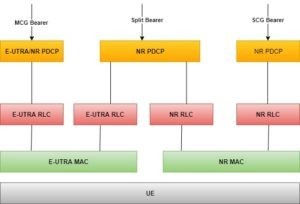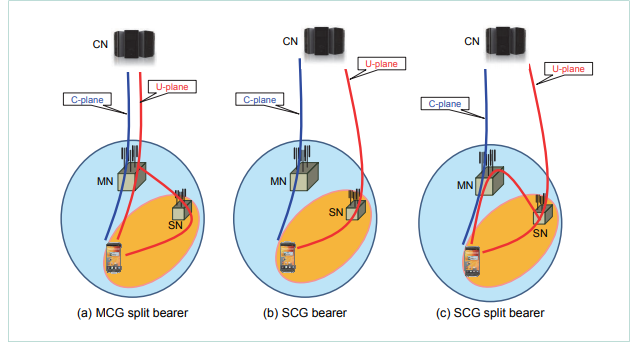What is ENDC in 5G?
Been into telecom background… Voice service is given the utmost importance… and planning and optimizing for better Voice service is the end goal for any organization or Telcom companies…
In the coming days… the 5g deployed world will be more important than ever, through various types of use cases. To enable the service providers to give premium 5G data & voice services will be one of the important task & agenda
Let us understand what is ENDC in 5G?
ENDC stands for Evolved-Universal Terrestrial Radio Access New Radio Dual Connectivity || E-UTRA NR Dual Connectivity || EPS core New Radio Dual connectivity.
ENDC is a concept of dual connectivity & is a 5G - Non-standalone (NSA) approach i.e. we call as Initial launch of 5G. Hence, it would be dual connectivity. The idea of ENDC is to utilize the power /gain of 5G NR i.e high-speed Thrpt while using a core network of 4G/EPC. Looking at evolution – looks like this is the only step towards the 5G technology/rollout. The only reason is that the 5G only core network is still not deployed anywhere in the world & it will be completely new platforms / Equipements to be deployed to make it possible to use 5G Core - This is costly and hence avoided.
Hence, Dual-mode looks like the only solution for the initial 5G deployment.
What does dual connectivity & how it works over here…

-
These works in Master & Secondary group concept in which.
-
LTE would become MCG (Master Cell Group) è So, MCG act as an anchor & UE will have to perform initial registration with MCG. After successful initial registration, this MCG would add one or more 5G Secondary Cells (SC or SCG).
-
5G NR would become SGC (Secondary Cell Group).
-
So, now UE can connect to 5G only after getting register on LTE, and then 5G Secondary cells will be added. Hence UE is connected to LTE – eNB && 5G – gNB at the same time.
-
All the signaling and data transfer aspects are been managed by 4G - EPC.
(Below is the diagram to it)
- NO direct 5G core connectivity in ENDC it’s via LTE eNB – Master Node, so 5G gNB will interact with LTE eNB for any core network functionality or core related task to assign or to be executed.
Working / Use of ENDC?
Assume, connectivity diagram with 4G been the prominent technology & 5G used for DATA.
C - Plan
For C - Plan what will be the connectivity be like ?
(Bullet points as below)

-
There is no direct control plane connectivity between gNB and EPC core.
-
LTE eNB acts as the Master node and 5G gNB acts as the secondary node.
-
There is a direct interface x2 between eNB and gNB.
-
5G gNB has a user plane interface with the SGW.
U - Plan
For U - Plan what will be the connectivity be like?
(Bullet points as below)

EN-DC from UE perspective
In EN-DC:: From a UE perspective - 3 bearer types exist:

-
MCG bearer ==> Network can configure either E-UTRA PDCP or NR PDCP for MCG bearers . MCG Bearer users RLC, MAC, and Physical layers within the Master Node. In the case of EN-DC, 4G (E-UTRA) is the master node. MCG bearer uses 4G implementation of RLC, MAC, and Physical layer and 4G air interface. PDCP layer can be configured in both 4G and 5G modes. PDCP layer is considered to be located within Master Node if the S1 connection is between SGW and e-Node.
-
SCG bearer ==> NR PDCP is always used . A bearer terminating at SN node (in case of EN-DC, more specifically at gNB). As the name indicates, the Secondary Cell group bearer uses the RLC, MAC, and Physical layers within the Secondary Node. In other words, it uses the 5G implementation of these layers and 5G air interface. SCG Bearers always use the 5G version of the PDCP layer no matter it is Master or Secondary Node.
-
Split bearer ==> NR PDCP is always used. Split Bearer uses the RLC, MAC and Physical layers within both the Master and Secondary Nodes, i.e., both 4G and 5G air-interfaces can be used. Split Bearer always use 5G version of the PDCP layer irrespective of the node providing the S1 connection towards the S-GW. UE cannot distinguish Split bearers as it always uses 5G version from the perspective of PDCP layer. The location of S1 interface is transparent to the UE and both Split bearers appear to be the same from UE perspective.
Split Bearer: Traffic is routed via LTE and/or NR bearer. Split bearer is further either SCG split or MCG split .
MCG Split: Traffic is splitted at MN node.
SCG Split: Traffic is splitted at SN node.
Bearer Concept
Below is the detailed diagram for the Basic representation of the Bearer Concept
That’s all from Bearer Concept, Now let us understand the RRC entity which is one of the important topics in 5G.
RRC Entity
(Summarizing in bullet points)
-
Each radio node has its own RRC entity.
-
If it’s an eNB => E-UTRA is the version of the RRC entity
-
If it’s a gNB => NR is the version of the RRC entity.
-
For the above both the RRC entity can generate RRC PDUs to be sent to the UE.
-
RRC PDUs generated by the SN (Secondary Node) can be transported via the MN (Master Node i.e LTE i.e eNB) to the UE.
-
The Master Node always sends the initial SN RRC configuration via MCG SRB (SRB1), but, Subsequent re-configurations may be transported via MN or SN and can directly send to the UE over SRB3.
-
When transporting the RRC PDU from the SN, the MN does not modify the UE configuration which was/is provided by the SN.
Conclusion
I hope you had a good time reading it & got lots of new things to learn… So tell me was the above information helpful?
Please comment, Follow me for more updates…
Share with colleagues …Feel free to Add… Comment… Suggest…
You can also find me in Linkedin: PARTH CHOLERA - RMSI | LinkedIn



